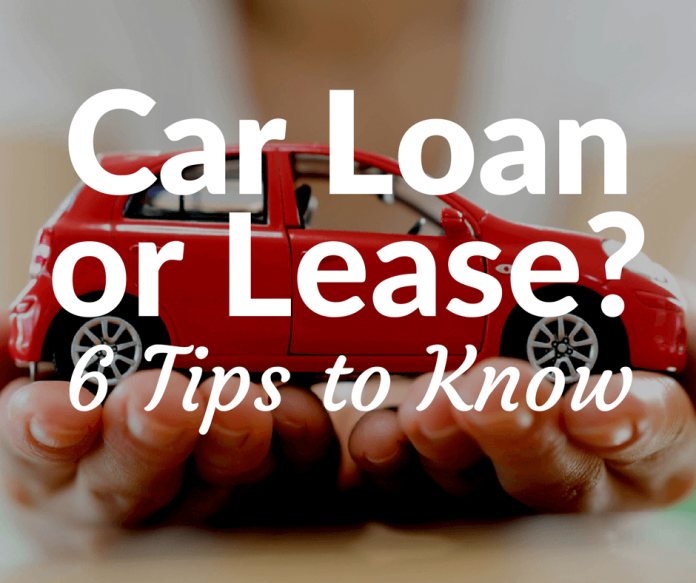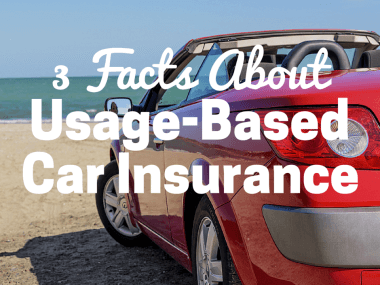Car Loan or Lease? 6 Tips to Know Which Option Is Best
What’s the difference between a car loan and car lease? Here are 6 tips to know which option is best for you.
For many people, the cost of financing or leasing a vehicle is one of your largest monthly expenses. Unless you live in a city with easy access to public transportation or have plenty of ride sharing services, you probably need your own vehicle to get to work, run errands, and have fun.
But choosing whether to get an auto loan, a lease, or to pay cash for a vehicle can be confusing. Having a monthly payment can also become a huge burden if your financial life takes a turn for the worse.
Buy Now

A Money Girl listener named Diana G. is in this camp. She says, “I have an auto loan that I can no longer afford. Since I’m upside down on the loan by over $8,000 and can’t trade in the vehicle, what are my options?”
In this post, I’ll answer Diana’s question, explain the differences between financing and leasing a vehicle, and cover six tips to know which option is best for you.
How Buying a Car with a Loan Works
When you purchase a vehicle with an auto loan you make fixed monthly payments, including interest, over a set amount of time. In some cases, an auto dealer or lender may not require a down payment; however, the more you pay upfront, the lower your debt and payments will be.
For example, if you buy a new car for $30,000 and make a 20% or $6,000 down payment, you make up the difference by financing $24,000. Your monthly payments are determined by the interest rate and length of the loan. Other factors include whether you buy a new or used vehicle, the price, your credit, and how much you earn.
While a lower monthly payment always sounds good, the longer your repayment term, the more interest you pay over the life of the loan.
Diana didn’t mention the details of her loan, but let’s say she borrowed $24,000 at a 4% APR (annual percentage rate). For a 3-year loan, her monthly payment would be $708, and a 6-year loan would be $375.
While a lower monthly payment always sounds good, the longer your repayment term, the more interest you pay over the life of the loan. Plus, longer auto loans make it easier to get “upside down,” which is the situation Diana said she’s facing.
Being upside down is financial jargon that means you owe more than the underlying asset is worth. So, if you get into a situation where you need to sell the car or make an insurance claim because it gets stolen or totaled in an accident, you might not receive enough money to pay off your loan in full.
When you’re dealing with a potential buyer or an insurance company, they only pay market value for a vehicle, even if it’s less than what you owe for it. To pay off your loan, you’d have to make up the difference from savings—that’s a bummer.
Although we need vehicles, they’re typically terrible investments because they depreciate very quickly. New cars can lose as much as 25% of their value after just one year. That’s why used or pre-owned vehicles make a lot of sense; the first owner takes the biggest depreciation hit.
The best way to prevent being upside down on a car loan is to make as big a down payment as possible, so you have equity in the vehicle. Plus, paying more upfront increases your ability to get approved for a loan at the lowest interest rate, which reduces your payments and cuts your interest expense.
Another way to borrow less for a car is to trade-in your current vehicle—if the dealer will offer you a fair value. The trade-in value is deducted off the purchase price of a new or used vehicle.
When buying a car, make a goal to pay at least 20% of the purchase price, including any trade or promotional rebate, to get the best deal. And do your homework before stepping on a car dealer’s lot. Know the purchase price of the car you want, the value of any trades or rebates, the amount of cash you can put down, and the monthly payment you can afford.
At the end of the article I’ll offer advice on what to do when you need to get rid of a vehicle with a loan or lease that’s putting a tight squeeze on your finances.
How Leasing a Car Works
A third of new car and truck transactions in the U.S. are leases, which can be attributed to the soaring cost of vehicles. A car lease is a contract that allows you to use a vehicle over a set amount of time.
Unlike with a car loan, you should pay as little down as possible with a lease, since you never build equity in a lease deal.
Your lease payments compensate the dealer for depreciation that will occur during your lease term, plus additional fees that give them a profit for making a deal with you. There’s typically a down payment due at a lease signing, such as 10%.
Unlike with a car loan, you should pay as little down as possible with a lease, since you never build equity in a lease deal. In other words, only pay the minimum required amount upfront. Also, it’s best to lease new vehicles only for a term that doesn’t extend beyond the warranty period.
Let’s say you lease a $50,000 car that will be worth $20,000 in three years when your lease expires. This $30,000 in depreciation, less any trade in or down payment, plus dealer fees, is the basis for the calculation of your monthly lease payments. That’s why lease payments can be much lower than loan payments for the same vehicle. Instead of paying for the entire car, you only pay for the estimated depreciation of the car during the time you lease it.
There are multiple factors that go into the calculation of a monthly car lease payment including the term (such as three or five years), the retail price of the car, your down payment, credit rating, depreciation, dealer fees, and state and local taxes.
Different makes and models of cars have very different depreciation rates. Those that depreciate the least are the best to lease. To research vehicle prices and depreciation rates, check out TrueCar and Edmunds.
Different makes and models of cars have very different depreciation rates. Those that depreciate the least are the best to lease.
At the end of the lease term you can return the car or purchase it at a pre-determined depreciated value, which is known as the residual value. The higher the residual value, the more it’s worth at the end of a lease and the lower your lease payments will be.
6 Tips to Know Whether a Car Loan or Lease Is Best
Now you know that leasing a car means having little or no equity with relatively lower payments. And getting a car loan means having partial equity with higher payments.
As I mentioned, whether you lease or buy them, vehicles are usually poor investments because they depreciate, no matter what. The best option depends on your lifestyle, financial goals, and how you intend to use a vehicle.
Use these six tips to consider your personal preferences and know whether a car loan or lease is best for you:
1. You don’t want to deal with potential car repairs.
A major advantage of leasing is that you don’t have to deal with major repairs because most are covered if you get a lease term that doesn’t exceed the manufacturer’s warranty.
A major advantage of leasing is that you don’t have to deal with major repairs because most are covered if you get a lease term that doesn’t exceed the manufacturer’s warranty. That protects you from having to pay for major repairs; however, you’re still responsible for routine maintenance.
When you return a leased vehicle, the dealer checks for damage and may charge you for repairs. If you tend to be an aggressive driver, consider purchasing an extended lease warranty that would cover parts such as new brakes or tires.
2. You want to drive a new car every few years.
Leasing can be attractive because you get to drive a newer or high-end vehicle, for a lower monthly payment, when compared to the cost of buying it for the same price and down payment. Even if you purchase a car using a low or no-interest loan, leasing is usually less expensive in the short term.
That makes it more affordable to drive a new vehicle with the latest options and safety features every few years. Depending on your lifestyle and occupation, keeping that new car smell with a luxury nameplate might be exactly what you want.
3. You don’t want the hassle of selling or trading in your old car.
There’s no doubt that leasing a vehicle is just more convenient than buying. You won’t have to worry about what to do with your old car when you’re ready for a new one. Plus, if the car is a lemon, you’re not stuck with it.
4. You want to drive a lot of miles.
While there are plenty of upsides to leasing, it comes with downsides as well. A biggie is that you’re typically charged a mileage fee if you drive more than 10,000 to 12,000 miles per year.
Depending on your work and lifestyle, maintaining low mileage may not be possible. When you borrow money to purchase a car, you can drive it as many miles as you want.
5. You want flexibility to change vehicles.
Another advantage of owning versus leasing a car is that you have flexibility to sell it or trade it in for a new one—even if you have an auto loan. But breaking a car lease is more restrictive and can be expensive. I’ll cover more about that in a moment.
You might be glad to own a vehicle if you…
- Lose your job and have trouble making payments
- Take a new job that requires you to drive more miles that exceeds the leasing mileage cap
- Need a minivan because twins are on the way
- Want to customize your vehicle
- Don’t want to maintain your vehicle perfectly
- Have any major life change that doesn’t make a leased car a good fit for you anymore
6. You want to pay as little for a car as possible.
The financial upside of owning a vehicle is that after you pay off the loan, you could drive it for years without a car payment.
The financial upside of owning a vehicle is that after you pay off the loan, you could drive it for years without a car payment. Once a car loan is paid off, a great strategy is to keep sending the same amount of money to a savings or retirement account.
If you can’t afford the higher payments of a car loan, consider buying a less expensive model or a reliable used car. However, you’re taking a risk that your car won’t need any expensive repairs after any warranty that you may have expires, which could easily wipe out the savings you hope to achieve.
How to Handle a Car Loan That You Can’t Afford
Let’s get back to Diana’s question about how to handle a car loan that she can’t afford and is upside down. If she sells her car or trades it in, she’ll have to continue making loan payments, so her best bet is to keep it.
One option that may make her payments more affordable is to refinance her auto loan. If she could get a lower interest rate or a longer repayment term, that would reduce her monthly payments.
I’d recommend that Diana contact her lender to discuss the options. If she doesn’t qualify for a refinance because her credit is poor or she lost her job, the lender may be able to suspend her payments temporarily or allow her to pay less for some time. Believe me, any lender would rather work out a deal than to have you default on a loan.
See also: 5 Ways to Get a Loan with Bad Credit
How to Get Out of a Car Lease Early
If you have a car lease that becomes unaffordable, review your contract and speak to the dealer so you understand the full cost of breaking a car lease. Here are three options to consider if you need to get out early:
Option #1: Return the car
Returning a leased car to the dealer before the end of a lease is never wise because you’re still on the hook for payments! Plus, you get hit with additional early termination fees and penalties.
If you don’t make lease payments, it hurts your credit, just like defaulting on a car loan does. So, if you must pay for the car, you might as well keep it and use it.
Option #2: Buy the car
Whether you should buy a car during a lease or at the end of the term depends on what price the dealer offers you.
If the vehicle’s market value is higher than the price, buying it might be a good idea. But if the car is worth less than what the dealer asks, it’s obviously a bad idea to buy it.
Option #3: Transfer the car lease
Transferring your car lease is the best option, but isn’t always a slam-dunk. It’s also called a lease trade and a lease assumption. It’s very affordable and doesn’t hurt your credit.
A lease transfer is when one person takes over the payments of a leased vehicle with the approval of the leasing company and assumes all the rights and responsibilities of the original agreement. The person with the lease is called the seller and the person who wants to assume the lease is called the buyer.
Sites like LeaseTrader and SwapALease allow you to advertise your vehicle and lease to prospective buyers. People who want to get out of a lease are matched up with people who want to take over a lease for the remainder of the term.
Find out what’s allowed under your existing contract. If your leasing company allows transfers, you’ll have much more flexibility if you need to get out early.
Should You Buy or Lease a Car?
If you like the benefits of leasing, it offers a more carefree lifestyle where you don’t have the headaches of ownership. But if long-term cost savings is your primary objective, then you should buy a car and drive it until the repair costs begin to exceed the cost of replacing it.
Remember that leasing is just another form of financing, so it’s still very important to negotiate the price of the car, known as the capitalized cost, just like you would if you were buying it. Focus on the capitalized cost more than the amount of your monthly payment. You can use a Buy or Lease Calculator to help crunch the numbers.
Get More Money Girl!
If you’re ready for help managing debt, building credit, and reaching big financial goals, check out Laura’s private Facebook Group, Dominate Your Dollars! Request an invitation to join this growing community of like-minded people who want to take their financial lives to the next level.
To connect on social media, you’ll find Money Girl on Facebook, Twitter, and Google+. Also, if you’re not already subscribed to the Money Girl podcast on Apple Podcasts or the Stitcher app, both are free and make sure that you’ll get each new weekly episode as soon as it’s published on the web. The show is also on the Spotify mobile app! Click here to sign up for the free Money Girl Newsletter!
Download FREE chapters of Money Girl’s Smart Moves to Grow Rich
Hand with Car image courtesy of Shutterstock






